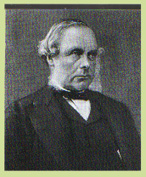
Joseph Lister in later years
|
|
|
|
|
|
|
|
|
|
|
|
|
|
|
|
|
|
Joseph Lister (1827-1912)
 |
Joseph Lister in later years |
| The Mansell collection |
So, who was Joseph Lister?
Joseph Lister was born on the 5th April, 1827 at Upton, Essex, England. He obtained a Bachelor of Arts degree from University College, London and then continued as a medical student in 1848. He was influenced by the physiologist William Sharpney and obtained his medical degree in 1852.
In 1856, Joseph Lister became an assistant surgeon at Edinburgh Royal Infirmary, where he met his future wife, who was extremely interested in his work.
Lister was appointed to the Regius Professorship of Surgery at Glasgow University in 1861 and was later made surgeon at Glasgow Royal Infirmary.
What were hospital conditions like at this time?
Conditions in operating theatres in hospitals were very unhygienic at the middle of the nineteenth century. As a result some 50 percent of patients died due to infection after surgery. The infected wounds were generally known as 'hospital gangrene' or sepsis, the Greek word for 'putrefaction'. The common belief seemed to be that sepsis was caused by the exposure of moist body tissue to air, with the resultant claim that wounds should be covered to keep the air out.
What was Lister's viewpoint?
Lister did not believe that exposure to bad air alone led to infection, but that some form of decomposition of the open wound was happening. After reading the work of Louis Pasteur, he thought that he might be able to kill bacteria which were getting onto the wound from the air. It has been suggested that he had recalled the old idea of covering amputations with tar and got the idea that the pure carbolic acid found in tar could destroy the bacteria. As a result, he soaked dressings in carbolic acid and had them applied to wounds immediately after an operation. He also had a spray of carbolic acid directed on the wound during an operation.
 |
An operation around 1870. A fine mist of carbolic acid is sprayed on the wound. The surgeons wear ordinary clothes and no masks. |
| Radio Times Hulton Picture Library. |
Lister continued his experiments for two years, and in 1867 made public that carbolic acid was an antiseptic, i.e prevented the wounds he had treated from going septic.
What else did Joseph Lister achieve?
As a result of Lister's work and similar work in hospitals in Germany, the drive for cleanliness gathered pace and it became commonplace for staff in operating theatres to wear long white gowns which easily showed dirt and use surgical gauze to meticulously clean sores and wounds.
In 1871 Lister was successful in lancing an abscess in Queen Victoria's left armpit.
In 1877 Joseph Lister was appointed to the Chair of Clinical Surgery at King's College University Hospital, London. He was able to continue his work on the development of antiseptics and 'clean' surgery until his retirement in 1893.
Joseph Lister died at Walmer, Kent, England on the 10th February 1912.